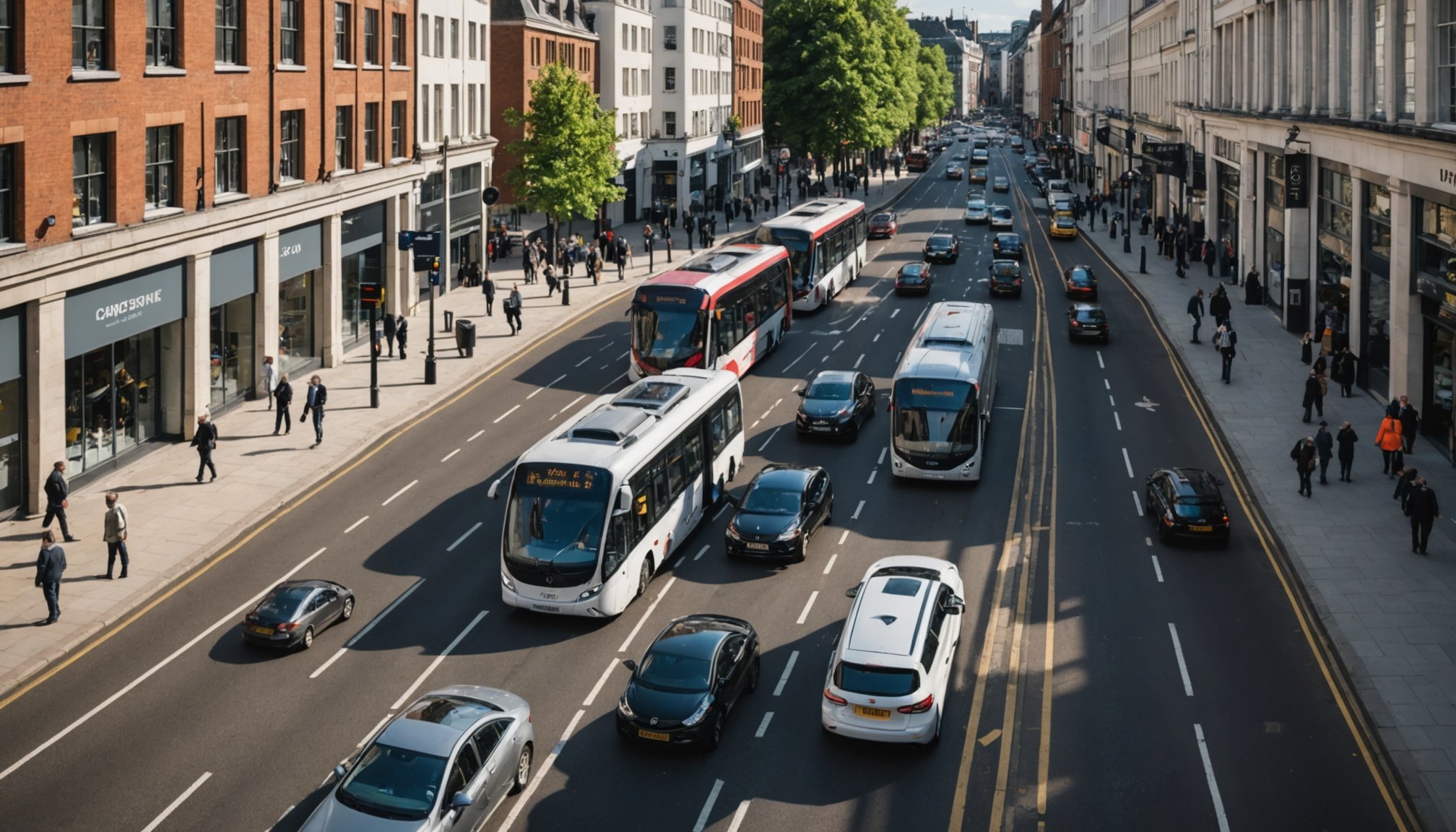Overview of AI in Traffic Management
AI traffic management is revolutionising the way we navigate our cities, transforming them into smart urban transportation hubs. The integration of Artificial Intelligence into traffic systems involves the use of advanced technologies like machine learning algorithms, analytics, and IoT devices. These innovations allow for real-time data collection and analysis, leading to dynamic traffic flow adjustments and enhanced safety measures.
Tracing its historical context in the UK, the adoption of AI technologies in transportation began gaining momentum over the past two decades. Initially, AI was leveraged primarily for predictive analyses and enhancing public transport schedules. However, its application has rapidly expanded to include adaptive traffic signals, autonomous vehicle trials, and congestion reduction strategies.
Also to discover : Revolutionizing telecom customer experience in the uk: harnessing the power of ai innovations
Key technologies underpinning AI traffic management include computer vision for monitoring road conditions, AI-powered sensors for vehicle detection, and predictive analytics that foresee potential traffic jams. These advancements optimise travel time, reduce emissions, and enhance commuter experiences. Moreover, AI-enabled systems improve traffic incident response times by providing authorities with precise data, allowing for quicker interventions.
Ultimately, these technologies play a crucial role in developing efficient, sustainable traffic solutions, fostering a safer and smoother journey for all urban users. The UK’s visibility and leadership in this sector continue to inspire global advancements in smart transportation solutions.
Additional reading : Revolutionizing visitor interactions: cutting-edge ai solutions in uk museums
Case Studies of AI Implementation in UK Cities
Delving into the realm of AI case studies within the context of UK urban transportation, cities like London, Manchester, and Bristol are making significant strides.
London: Smart Traffic Signals
London’s traffic signal optimisation project stands as a testament to the potential of artificial intelligence. By incorporating advanced algorithms, the city has successfully tackled congestion, leading to notable reductions in travel times. The project focuses on adjusting signal timings in real-time to respond efficiently to traffic fluctuations. Residents and environmental groups have largely praised this development, noting improvements in air quality and urban mobility.
Manchester: Predictive Traffic Analytics
Manchester has embraced predictive analytics to revolutionise its traffic management. By analysing vast amounts of data, the city can foresee and alleviate traffic jams before they occur. This data-driven decision-making has resulted in smoother traffic flow and reduced delays. The success of these models heralds potential future expansions to include more dynamic, city-wide applications.
Bristol: AI-Driven Public Transport Systems
The transformation of Bristol’s public transport services with AI has proven immensely beneficial. Enhanced with smart systems, public transport has become more reliable and efficient, significantly reducing the carbon footprint. Feedback from commuters has been overwhelmingly positive, highlighting smoother commutes. Continuous stakeholder engagement ensures the initiative evolves based on public needs and feedback.
Benefits of AI for Urban Mobility
Artificial Intelligence (AI) is revolutionizing urban mobility, offering substantial benefits for today’s growing cities. One key advantage is enhanced traffic flow, which directly affects congestion levels. AI systems analyze real-time data, optimize traffic signals, and reroute vehicles. This dynamic adjustment promotes smoother journeys.
Another notable benefit is improved safety. AI-powered systems monitor driving patterns, identify and predict risky behaviours, and alert drivers to potential hazards, ultimately leading to reduced accident rates. AI’s ability to process vast amounts of data enables more informed decisions, safeguarding passengers and pedestrians alike.
Additionally, AI brings increased efficiency to public transportation services. Predictive algorithms anticipate passenger demand, allowing for optimal scheduling and route planning. This results in reduced waiting times and fewer delays for commuters. Furthermore, AI aids in the maintenance of public transport vehicles by predicting mechanical issues before they occur, ensuring reliability and safety.
Through these advancements, AI is redefining urban mobility, making it more efficient and safe for everyone involved. As technology continues to evolve, it promises to offer even more improvements, guiding cities towards sustainable futures.
Statistics on Traffic Improvement
Traffic congestion has long been a frustration for urban areas. The implementation of AI-driven solutions has produced noteworthy traffic improvement statistics. An analysis of different urban centers reveals significant reductions in congestion. For instance, in cities where AI traffic systems were adopted, reports indicate a 15-20% decrease in peak hour traffic.
AI impact data also highlights changes in travel time and overall efficiency. By optimizing traffic lights and predicting congestion patterns, AI systems improve the flow of vehicles, reducing travel times by up to 25%. This not only helps individuals reach destinations more efficiently but also decreases fuel consumption and emissions.
When comparing congestion levels before and after AI adoption, a stark contrast in traffic fluidity is evident. Previously congested routes have been transformed into smoother journeys, encouraging a broader embrace of AI technology in city planning.
Economically, the improvement in traffic flow due to AI integration can expand mobility and accessibility significantly. This enables businesses to operate with greater efficiency and individuals to access more opportunities. Additionally, the reduction in idle time on roads translates into savings on fuel costs, showcasing the potential for positive economic ripple effects.
Challenges in AI Traffic Management
Navigating the complex landscape of AI deployment in traffic management presents several challenges. Technological barriers are a primary concern, particularly when integrating AI systems within current transportation infrastructures. Many existing systems are not immediately compatible with advanced AI technologies, necessitating significant upgrades or overhauls. This can lead to increased costs and extended timelines, complicating the adoption process of AI in transportation management.
Furthermore, public concerns around data privacy and surveillance add another layer of complexity. AI systems often rely on vast amounts of data to function optimally, increasing apprehensions about how this data is collected, stored, and used. Addressing these concerns is vital for building public trust and ensuring compliance with privacy regulations.
In addition, securing adequate funding and resource allocation for AI initiatives in traffic management remains a considerable hurdle. The implementation of AI technology typically requires substantial investment, not only in terms of finances but also in human capital and training. Prioritizing how these resources are allocated is crucial for the successful deployment and sustainability of AI solutions within transportation networks. Overcoming these challenges is essential for realizing the full potential of AI in traffic management.
Future Trends in Smart Transportation Systems
The future of transportation is rapidly evolving, spurred by cutting-edge smart city innovations. Emerging technologies promise to transform traffic management, making cities more efficient. For example, adaptive traffic lights can adjust their timing based on real-time data to improve flow and reduce congestion. This could significantly enhance urban living by making commutes faster and reducing emissions.
A key innovation is the potential for AI integration with autonomous vehicles. AI systems can process vast amounts of data to make instant decisions, enhancing safety and performance. Imagine vehicles communicating with each other and the city’s infrastructure to avoid collisions and improve navigation. This synergy could lead to safer roads and improved traffic conditions.
Envisioning interconnected smart city ecosystems for mobility provides a fascinating glimpse into the future. Such ecosystems would comprise seamlessly linked transportation networks, where public transit, private vehicles, and micro-mobility options like e-scooters function in harmony. This network would be supported by robust data-sharing platforms ensuring real-time information access for commuters.
These advancements could transform urban landscapes. The growing adoption of these technologies heralds a future where cities are not only smarter but also more sustainable and efficient, pointing towards an era of integrated, streamlined mobility solutions.






